First Honey Harvest!
This has been a phenomenal year for the bees in our area: moderate temperatures, adequate rainfall (which cannot be said for most of the country), and a good nectar flow as a result. We'd already heard from other beekeepers saying that they were pulling massive amounts of honey off of their hives, but this is our first harvest, so we didn't know what to expect.
In the spring, we'd added a medium honey super onto the hive for collecting honey. The way it works is that the bottom boxes on the beehive are used for both storing honey and raising young bees (brood), but the honey is for the bees, for their winter food source. To collect honey for harvesting, you first add a queen excluder to the top of the hive; the wires are wide enough to allow the workers to pass through, but the queen--being slightly larger than the workers--cannot fit and so stays in the bottom of the hive. This prevents you from getting brood mixed in with your honey. Then you add a box (super) on top of the queen excluder that the bees fill up with honeycomb and honey.
There are a few different ways to harvest honey. Since we were only pulling off one super with eight frames, it wasn't worth it for us to rent the centrifuge from the Carroll County Beekeepers Society, so we harvested using a fume board and the crushed-comb method. The fume board is a cloth pad that you spray down with volatile essential oils; they smelled lovely to me, but the bees don't like them. You place the fume board on top of the honey super, and within five minutes, the bees have moved away from it and into the bottom of the hive, leaving the honey super empty. A frame is normally liberally covered in bees:
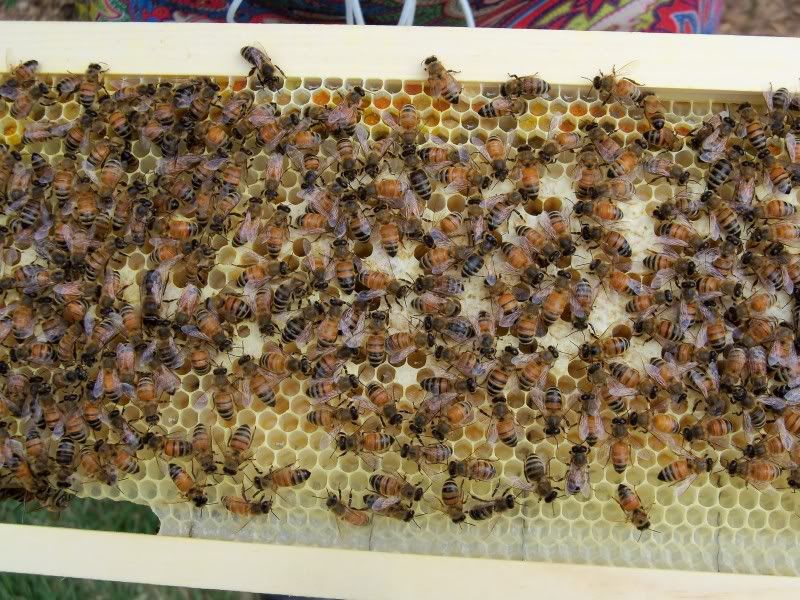
However, once the fume board did its thing, we had about ten bees left in the entire honey super.
I think Bobby and I were both a little nervous about the first harvest. For obvious reasons, bees don't appreciate having their honey taken. However, it was a perfect day for "going in the bees"; it was cool and dry (hot, wet weather pisses them off and makes the beekeeper uncomfortable too). Although I usually only wear, at most, a veil in the bees, I did the full suit, everything but the gloves. (I'm honestly more nervous about dropping a frame full of bees than I am getting stung on the hand. I've been stung on the hand before; it hurts, but it heals.) Bobby and I planned our approach ahead of time; we opened the hive and got the fume board in place, then went in the house to wait. The bees were fine; no one pinged us or even seemed to care that we were there.
Next, we went out to remove the honey super. Our first year behind us, we have decided to take a hands-off approach to the bees as much as possible, since going into the hive seriously disrupts them and requires them to repair the damage we cause. So we hadn't been in ... well, in a while. As a result, the honey super was very "propped up": Bees produce a sticky, dark golden substance called propolis that they use to seal up the hive. Every crack and crevice gets "propped up." We had to pry apart the honey super and the queen excluder. This was the hardest part, and not only because of all the propolis.
I was prying up the honey super with the hive tool while Bobby tried to lift it free. "What's the matter?" I asked. "It looks like it's mostly come free."
"It's not the propolis," he said. "It's heavy."
When we took the beekeeping course, we were advised not to use large supers--called "deeps"--for honey because, when filled, they become so heavy that they're almost impossible to lift. We use mediums as a result. My husband is no weakling, and he had trouble lifting the medium! Finally, we got it free of the hive; he carried it around the side of the house while I put the hive back together. The bees were still calm and seemingly oblivious to what we were doing. I got the cover back on in no time.
When bees store honey, they first draw out the comb, then fill it with honey; when it's full and ready for long-term storage, they cover the comb with a wax cap. That's what you look for when you go into your honey supers: the pale yellow wax caps that tell you that you have a frame full of finished honey.
We took the honey super into the house after removing a few stray bees. Here was the first frame that we pulled out.
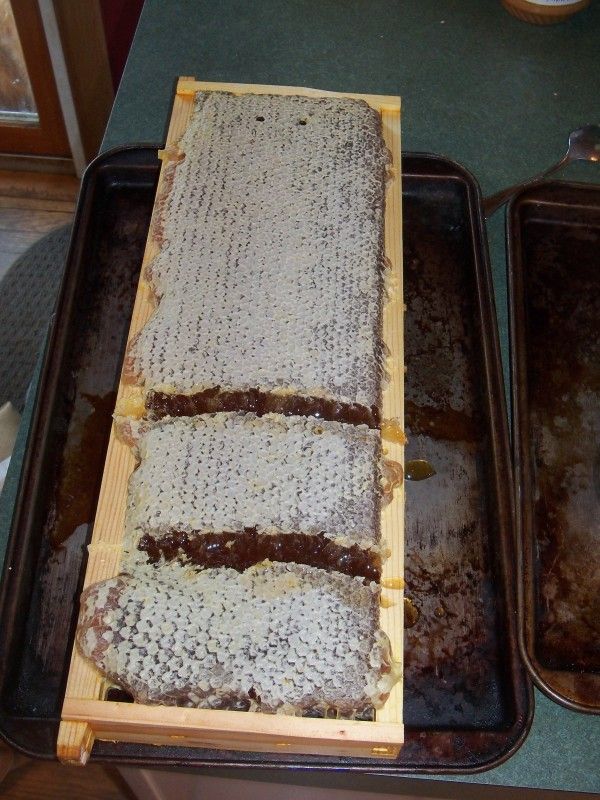
It was nothing but capped honey. We loosened all of the frames (the bees prop those too), and every last inch was full of capped honey.
Here's the super, minus that first frame:
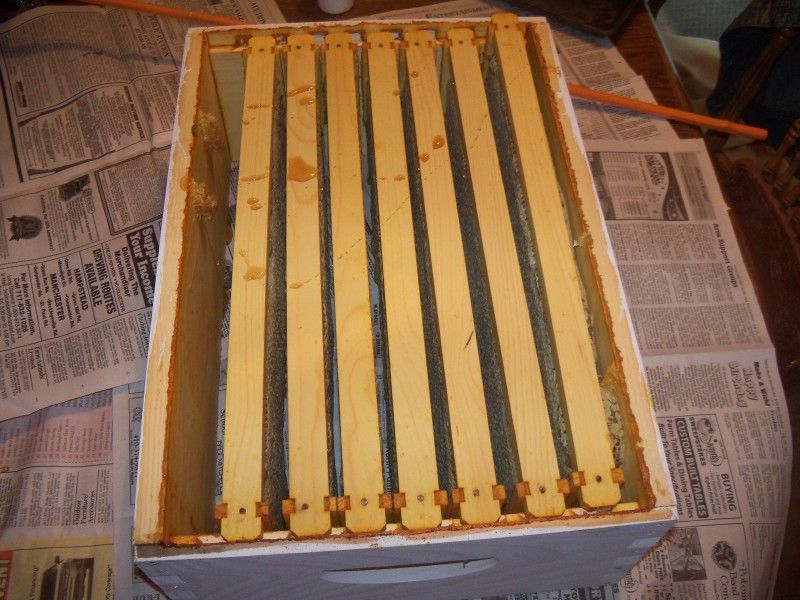
You can see the honey spilling out onto the tops of the frames. Bobby and I both took a taste--what an amazing experience! It was wonderful!
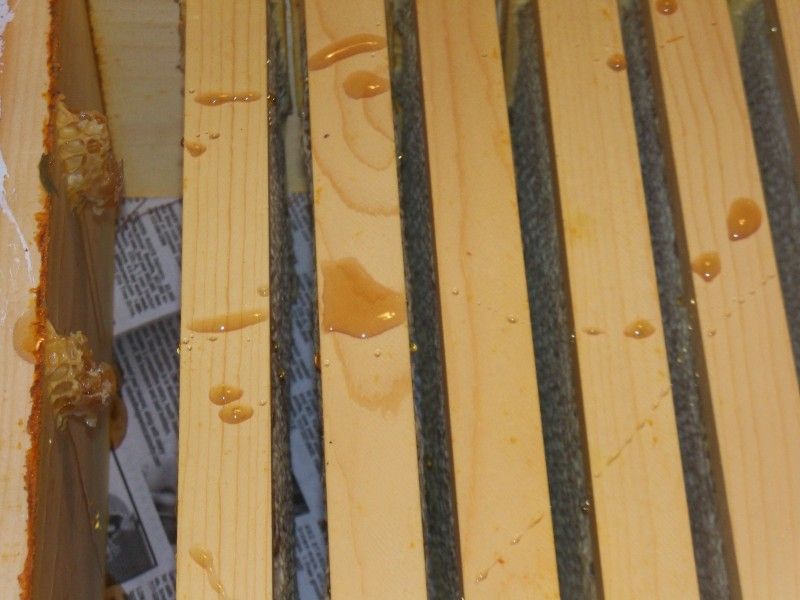
When you use the centrifuge, you use a hot knife to cut the caps off of the honey but save the comb itself and put it back into the hive for the bees to reuse. The crushed-comb method that we used, unfortunately, you have to destroy the comb, so the bees have to start over in building it. However, for us, this is not all bad, as we wanted to keep bees not only for the honey but the wax, which we will make into candles. With a kitchen knife, you cut the comb out from the frames. Here is a cross-section of comb, full of honey:
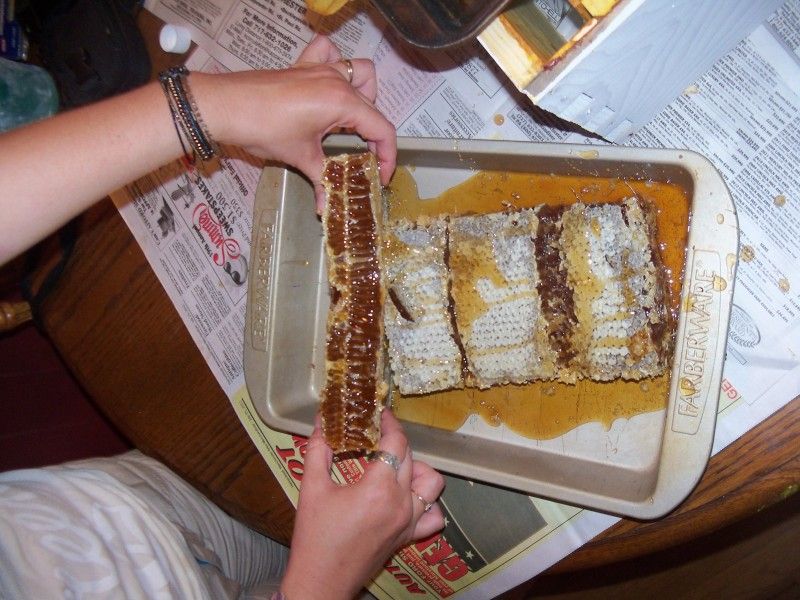
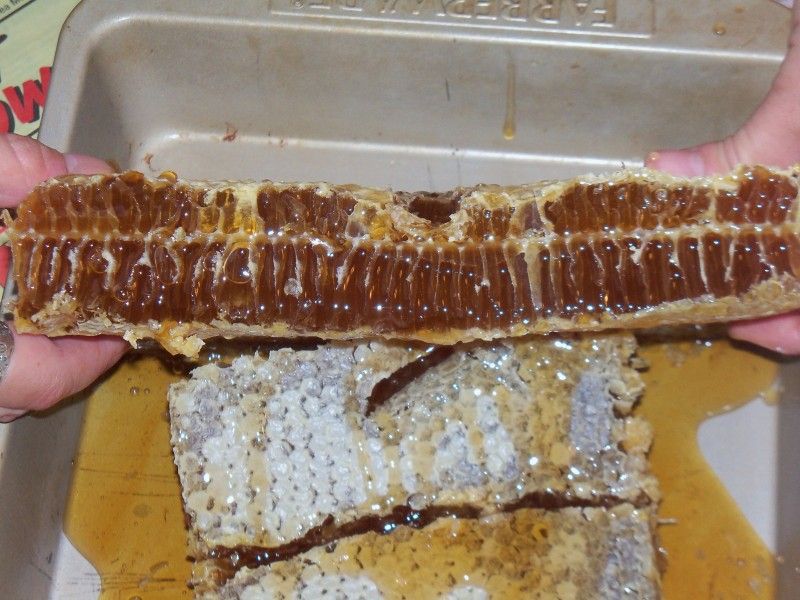
Next, you use a pestle to mash up the comb.
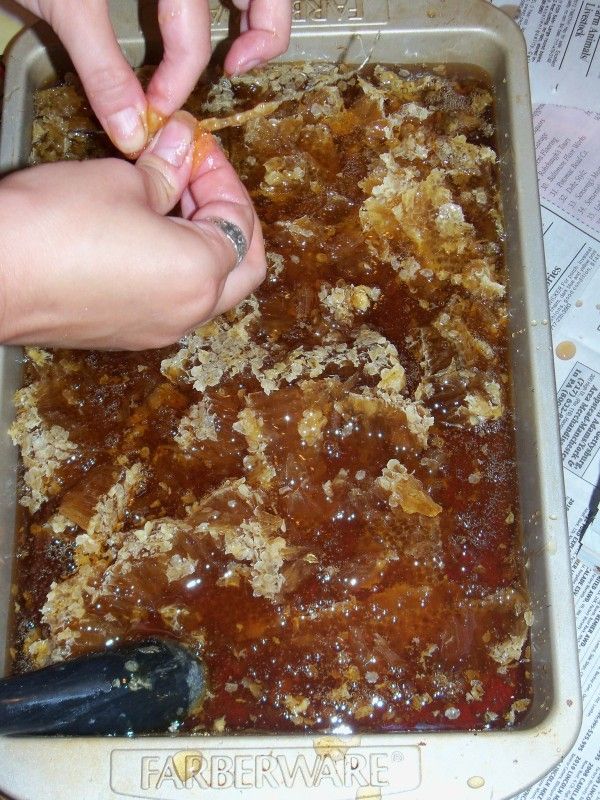
(I'm pulling out the little wire bits that hold the wax foundation in place on the frame.)
That mess of honey and wax gets dumped into a bucket lined with a fine mesh bag. The honey runs through the mesh and into the bucket, where Bobby uses a spigot to fill jars.
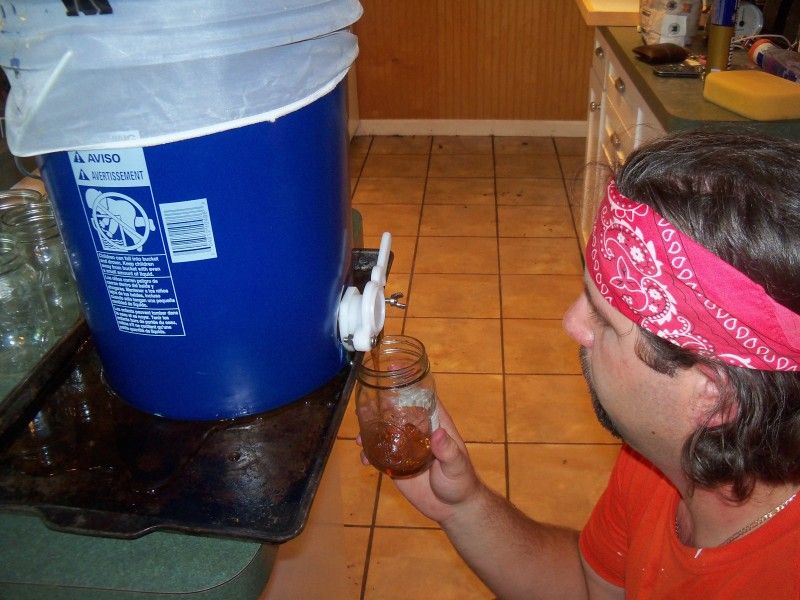
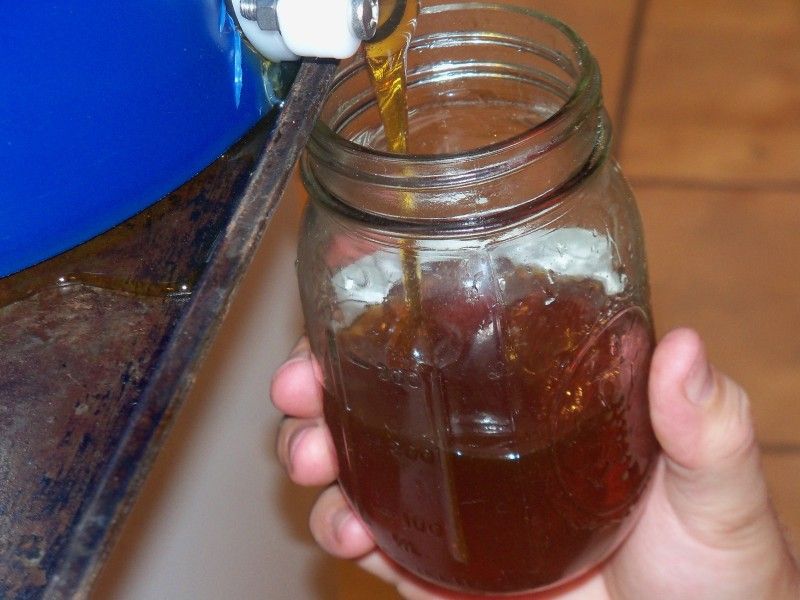
Filled honey jars, just waiting on lids.

Processing honey is messy! It gets everywhere. I'm sure the dogs loved licking the floor when we were done. The front of my shorts were soaked through to the skin with honey.
When we'd processed all eight frames, we figure we ended up with about 25 pounds of honey. We ended up with enough honey to last us for the year, enough wax to make about 75 votive candles, and spare honey for mead and gifts for friends and family.
Once finished, we tossed the empty, honey-coated frames and equipment in front of the hive; the bees will clean it up and re-store the remnants of the honey. Tomorrow, Bobby will replace the wax foundations in the frames, and we will put the honey super back on so that they can start working on their winter stores. We generally get another nectar flow in the fall; we'll also start feeding them again to get their stores up for the winter.
Here is the final harvest (minus the two jars that Bobby just did from the last of the honey to drain off):
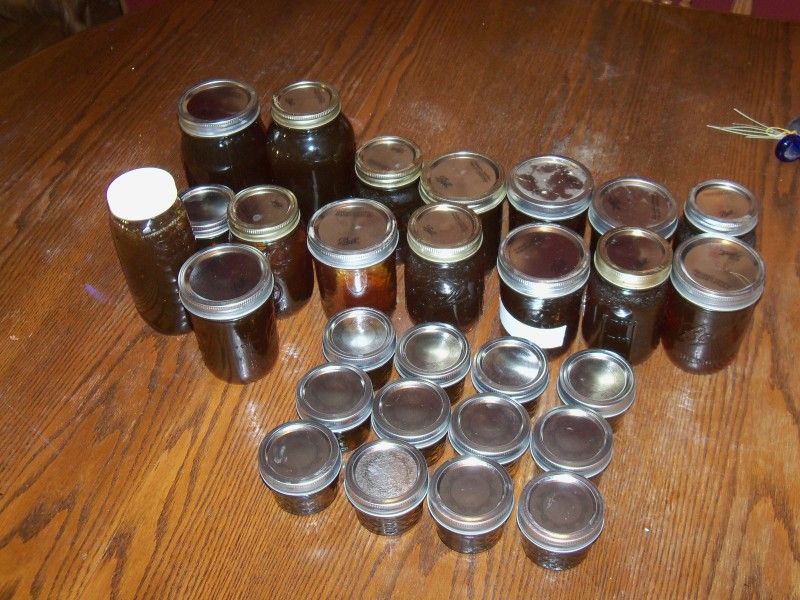
It's a beautiful time of the year, full of life and abundance. Here is the honey along with the veggies and eggs that are also part of our seasonal harvest.
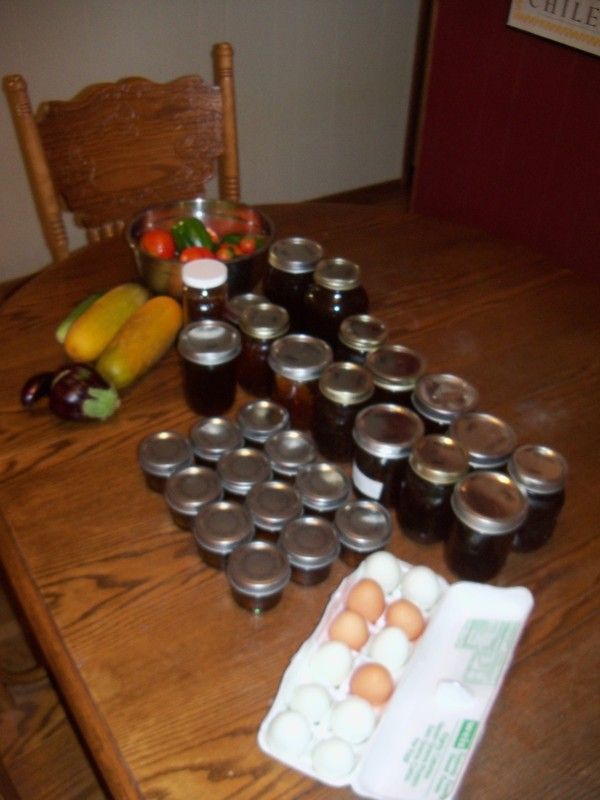
And the beautiful, clear golden color of the honey.
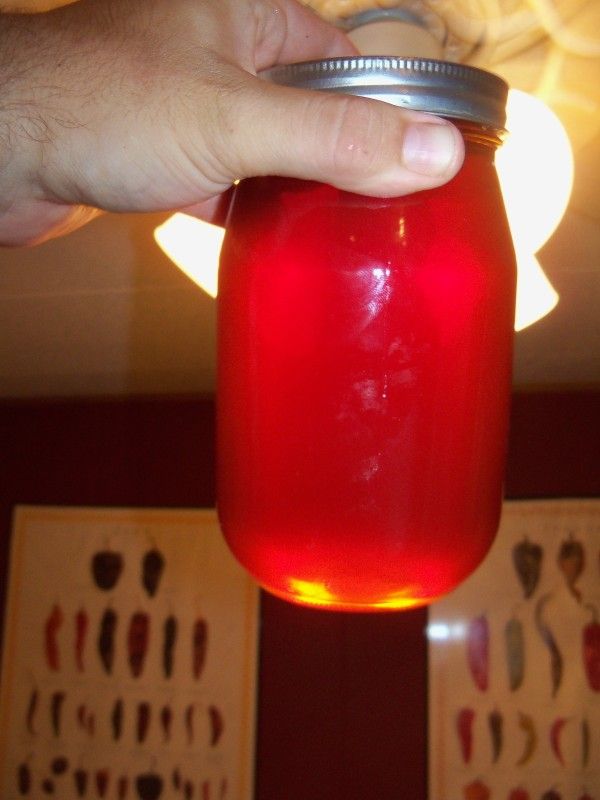
This post was originally posted on Dreamwidth and, using my Felagundish Elf magic, crossposted to LiveJournal. You can comment here or there!
http://dawn-felagund.dreamwidth.org/300323.html
In the spring, we'd added a medium honey super onto the hive for collecting honey. The way it works is that the bottom boxes on the beehive are used for both storing honey and raising young bees (brood), but the honey is for the bees, for their winter food source. To collect honey for harvesting, you first add a queen excluder to the top of the hive; the wires are wide enough to allow the workers to pass through, but the queen--being slightly larger than the workers--cannot fit and so stays in the bottom of the hive. This prevents you from getting brood mixed in with your honey. Then you add a box (super) on top of the queen excluder that the bees fill up with honeycomb and honey.
There are a few different ways to harvest honey. Since we were only pulling off one super with eight frames, it wasn't worth it for us to rent the centrifuge from the Carroll County Beekeepers Society, so we harvested using a fume board and the crushed-comb method. The fume board is a cloth pad that you spray down with volatile essential oils; they smelled lovely to me, but the bees don't like them. You place the fume board on top of the honey super, and within five minutes, the bees have moved away from it and into the bottom of the hive, leaving the honey super empty. A frame is normally liberally covered in bees:

However, once the fume board did its thing, we had about ten bees left in the entire honey super.
I think Bobby and I were both a little nervous about the first harvest. For obvious reasons, bees don't appreciate having their honey taken. However, it was a perfect day for "going in the bees"; it was cool and dry (hot, wet weather pisses them off and makes the beekeeper uncomfortable too). Although I usually only wear, at most, a veil in the bees, I did the full suit, everything but the gloves. (I'm honestly more nervous about dropping a frame full of bees than I am getting stung on the hand. I've been stung on the hand before; it hurts, but it heals.) Bobby and I planned our approach ahead of time; we opened the hive and got the fume board in place, then went in the house to wait. The bees were fine; no one pinged us or even seemed to care that we were there.
Next, we went out to remove the honey super. Our first year behind us, we have decided to take a hands-off approach to the bees as much as possible, since going into the hive seriously disrupts them and requires them to repair the damage we cause. So we hadn't been in ... well, in a while. As a result, the honey super was very "propped up": Bees produce a sticky, dark golden substance called propolis that they use to seal up the hive. Every crack and crevice gets "propped up." We had to pry apart the honey super and the queen excluder. This was the hardest part, and not only because of all the propolis.
I was prying up the honey super with the hive tool while Bobby tried to lift it free. "What's the matter?" I asked. "It looks like it's mostly come free."
"It's not the propolis," he said. "It's heavy."
When we took the beekeeping course, we were advised not to use large supers--called "deeps"--for honey because, when filled, they become so heavy that they're almost impossible to lift. We use mediums as a result. My husband is no weakling, and he had trouble lifting the medium! Finally, we got it free of the hive; he carried it around the side of the house while I put the hive back together. The bees were still calm and seemingly oblivious to what we were doing. I got the cover back on in no time.
When bees store honey, they first draw out the comb, then fill it with honey; when it's full and ready for long-term storage, they cover the comb with a wax cap. That's what you look for when you go into your honey supers: the pale yellow wax caps that tell you that you have a frame full of finished honey.
We took the honey super into the house after removing a few stray bees. Here was the first frame that we pulled out.

It was nothing but capped honey. We loosened all of the frames (the bees prop those too), and every last inch was full of capped honey.
Here's the super, minus that first frame:

You can see the honey spilling out onto the tops of the frames. Bobby and I both took a taste--what an amazing experience! It was wonderful!

When you use the centrifuge, you use a hot knife to cut the caps off of the honey but save the comb itself and put it back into the hive for the bees to reuse. The crushed-comb method that we used, unfortunately, you have to destroy the comb, so the bees have to start over in building it. However, for us, this is not all bad, as we wanted to keep bees not only for the honey but the wax, which we will make into candles. With a kitchen knife, you cut the comb out from the frames. Here is a cross-section of comb, full of honey:


Next, you use a pestle to mash up the comb.

(I'm pulling out the little wire bits that hold the wax foundation in place on the frame.)
That mess of honey and wax gets dumped into a bucket lined with a fine mesh bag. The honey runs through the mesh and into the bucket, where Bobby uses a spigot to fill jars.


Filled honey jars, just waiting on lids.

Processing honey is messy! It gets everywhere. I'm sure the dogs loved licking the floor when we were done. The front of my shorts were soaked through to the skin with honey.
When we'd processed all eight frames, we figure we ended up with about 25 pounds of honey. We ended up with enough honey to last us for the year, enough wax to make about 75 votive candles, and spare honey for mead and gifts for friends and family.
Once finished, we tossed the empty, honey-coated frames and equipment in front of the hive; the bees will clean it up and re-store the remnants of the honey. Tomorrow, Bobby will replace the wax foundations in the frames, and we will put the honey super back on so that they can start working on their winter stores. We generally get another nectar flow in the fall; we'll also start feeding them again to get their stores up for the winter.
Here is the final harvest (minus the two jars that Bobby just did from the last of the honey to drain off):

It's a beautiful time of the year, full of life and abundance. Here is the honey along with the veggies and eggs that are also part of our seasonal harvest.

And the beautiful, clear golden color of the honey.

This post was originally posted on Dreamwidth and, using my Felagundish Elf magic, crossposted to LiveJournal. You can comment here or there!
http://dawn-felagund.dreamwidth.org/300323.html